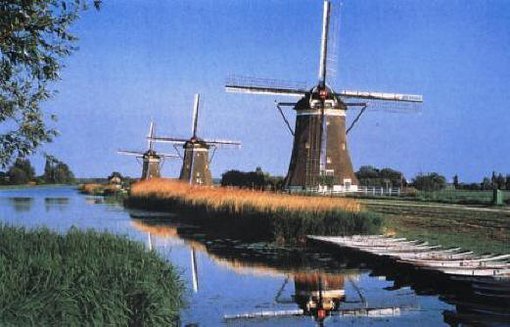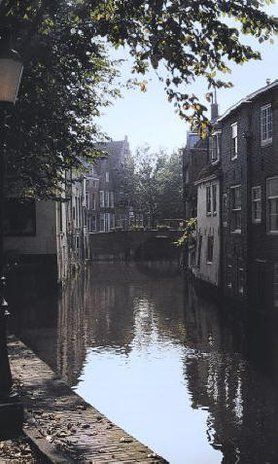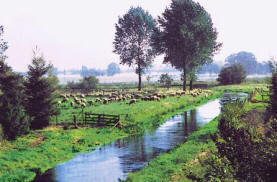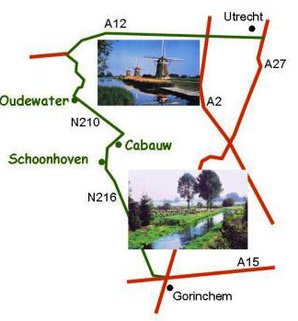




Continue on A12 towards Amsterdam, exit at Woerden and drive towards Oudewater. From there you drive south to Cabauw and on to Schoonhoven. Take the ferry over the river Lek and continue towards Gorinchem and join the motorway there. /20 km/
On this tour you travel through a flat landscape with woolly sheep and well-fed cows who will never come into contact with any electric fences as they graze the lush, green grass. The narrow canals criss-crossing the fields in a regular check pattern provide enclosure as well as drinking water for the animals.
THE WITCH TOWN OF OUDEWATER
The first town you reach is called Oudewater, which means Old Water, and this town is indeed both surrounded and traversed by water. The river Ijsel that runs through the town is a river with a grim and grisly past. One of the trials a woman accused of witchcraft had to go through during the Middle Ages was to be lowered, hands and feet bound, into the river. If she sank, she was deemed innocent! Another test was the weighing of “the witch”, and in Oudewater the “scale masters” were known for their honesty and refusal to take bribes from husbands wanting to get rid of their wives. So Oudewater received, from none other than Emperor Charles V, the right to issue a certificate which was valid all over his great realm, giving a guarantee to the holder that she would never be accused of being a witch. Consequently, women from all over Europe poured into the little town of Oudewater to be weighed and certified too heavy to be able to fly the devil’s errands on a broomstick.
Even today you can get weighed on the old wooden scales in the Heksenwaag Museum and have your certificate issued. What in medieval times was a matter of life and death is now just a tourist joke, but the sinister origins of this weighing ploy may escape many people. These antique and quite authentic scales have survived wars and destruction, like the great fire of 1575, caused by the Spanish army invading in a bid for conquest, laying waste huge parts of the town in ashes. The Heksenwaaghuis was built after that date, as were indeed most of the beautiful houses in the old part of the town, thus creating a homogenous unity. Take a stroll around the town and enjoy all the old houses along the canals. The fine house gables are built in reddish brown brick, decoratively striated in light sandstone, with the Town Hall as an especially magnificent example.
FROM MOAT TO IDYLLIC LAKE
After the many disasters the citizens started to examine their fortifications, gradually substituting the medieval town walls with sturdy embankments and wide, dug-out moats enforced with bastions. Already in the mid-19th century these constructions lost their importance and were demolished to make room for industrial sites. However, the old moats were allowed to remain and today form the heart of a parkland which offers the visitor tranquillity and relaxing nature strolls.
CABAUW
From Oudewater the journey continues along arrowstraight roads along canals on to the little village of Cabauw - if it can indeed be called a village, as it consists of not much more than a long road beside a canal which reflects, mirrorlike, the pretty houses with their idyllic little gardens.
SCHOONHOVEN
From Cabauw it is not far to Schoonhoven, another typical little Dutch town with canals and picturesque bridges. Here, too, beautiful medieval houses are lined up along the canals. One of them is the Town Hall, dating from the 15th century, with a belfry, boasting no fewer than fifty 18th century bells, still chiming. Walk along the quays down to the river Lek and you will arrive at Veerpoort from the 17th century, the only town gate to remain in its original form.
THE SILVER TOWN
Schoonhoven is also called The Silver Town after its centuries old silver manufactury. Many skilled silversmiths still work here. The produce can be admired in The Nederlandse Goud-Zilver-en Klokkenmuseum, which exhibits silver and gold merchandise as well as old clocks. Outside the museum stands the old weighing-house, De Waag, from the 17th century, where people could drive their carts straight in and wait for their wares to be weighed. This town is situated by the river Lek and you must now pay the fare and drive on board the little ferry that runs as a shuttle service over to the other side, before you can continue towards the motorway in the direction of Gorinchem.

DUTCH CANAL LANDSCAPE
Canal idyll at Qudewater
Sweet woolly sheep by a charming canal